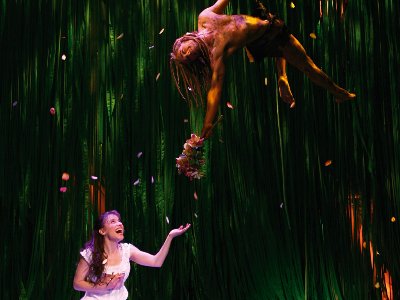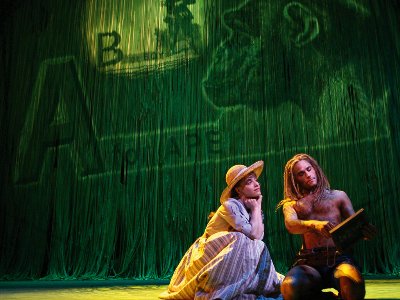Behind the Green Room
Page 2 of 4

(c) Disney
Click here for a much larger version of this picture
BEHIND THE GREEN ROOM
So what do you know about Tarzan? Although there are a multitude of books (Edgar Rice Burroughs wrote at least twenty-five himself) and countless movie and television adaptations of the property the odds are that there are only a handful of elements that you can recall: Johnny Weissmuller, Jane, Cheetah, swinging through the trees and that yell. So how do you bring Disney’s 37th animated feature to the stage without evoking those clichéd memories?
This is the story of how Tarzan swung onto the Great White Way.
Two key players from the Tarzan creative team cut their Disney theatrical teeth on the troubled Aida adaptation. After the public previews of their third musical Elaborate Lives failed to match internal expectations Disney Theatricals President Tom Schumacher brought in a new team including director Bob Falls, choreographer Wayne Cilento and Tarzan alumni writer David Henry Hwang and designer Bob Crowley. David was appointed to re-jig the original book by Linda Wolverton (Beauty and the Beast). That initial run in Atlanta was followed by another out of town tryout in December 1999 when Aida (as the show was now known) opened in Chicago prior to its Broadway debut in the spring of 2000.
“I first got the call from Tom about the possibility of bring Tarzan to Broadway within a year of the movie coming out,�? the show’s director, scenic and costume designer Bob Crowley says. “Disney asked for ideas of how we would stage this show. I had been to the premiere of the movie in New York and loved it. It seemed like it would be an ideal project for me to design. So my first question was who is directing it? They said “You can�?. I literally had to pick myself up off the floor. “If you come up with the big idea why would you want to give it away�? I was told. I laughed as I had spent my life doing that!�?
“I had been a designer all my life and never really had any desire to change that,�? Bob continues. “I had been asked to direct a few times before but nothing ever came of it. I wasn’t even sure if it was my true vocation as I felt I had been successful as a scenic and costume designer. You usually don’t get offers five years in advance in the theater and so I decided to fit the project in and go along for the ride.�?

(c) Disney
Click here for a much larger version of this picture
So Bob went away from that conversation with his head already filled with ideas. “Ultimately I ended up designing three different versions of the staging for Tarzan,�? Bob explains. “My initial idea was to stage the show in the round and that eventually evolved into having the audience sat either side of the stage. The problem was that we couldn’t find anywhere to host this type of show. So at the start of 2005 Tom asked if I could re-jig my sketches and conceive the show for a proscenium arch. Although the venue itself is different the look of the show is very similar to those initial ideas I penciled out years ago.�?
The overriding problem became how do you put Africa on stage? Bob’s solution was to not even try. “We just couldn’t be realistic for this show as you wouldn’t know where to begin,�? Bob outlines. “You can’t put nature on stage as it is a living and breathing environment that would require its own ecosystem. Anyhow I strongly believe that theater is at its best when it is working metaphorically by representing an idea. Movies can recreate almost whatever they desire but I can’t do that for the stage. I can put a real rainforest on the boards as much as I can put a real monkey on there! It is possible to have actors portraying monkeys so why not have scenery to represent the jungle? I chose electric and exotic colors which often clash to heighten the experience and opposites are striking for an audience. This isn’t a walk through Central Park as it is meant to be somewhere you haven’t been before. This jungle is vibrant and full of life.�?
“I actually had a good experience on Aida despite being a script doctor of sorts,�? David reveals. “Then in late 2001 Tarzan was presented to me. I had wanted to do another show with Disney but I honestly wasn’t sure how I felt about the story. I had seen the animated movie but all I seemed to have were these vague impressions of Tarzan like the loincloth, Bo Derek, Cheetah and that yell. I quickly realized that I didn’t know the story at all as there has been so many iterations. You think you know the story but all you really possess are these different feelings.�?
Like so many of his collaborators on Tarzan David opted to return to the source material first. “The book really resonated with me as being a tale about a guy caught between two worlds by virtue of him being of one ancestry and raised in another context,�? David theorizes. “Tarzan has a vague sense that he is of something else but no facts to back that up. He finally confronts his ancestry when the English expedition arrives in Africa and has to decide how to move forward. I could empathize with his dilemma as a Chinese-American. I found I could relate to Tarzan albeit in a different context as I have written about East-West relations a great deal.�?
